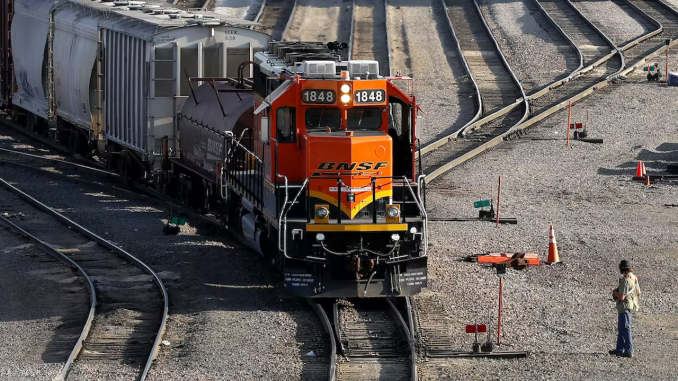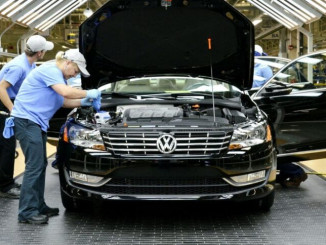
For those not familiar with the railroads, trying to follow the situation over the last few months can be confusing. We offer some clarification to help paint a clearer picture.
Freight and passenger rail operators in the U.S. have been negotiating with railroad workers’ unions for months now. Railroad workers, or “rails” as they sometimes refer to themselves, have been working without a contract for three years. Meanwhile, profits for the railroad bosses have soared, going from around 15% in 2001, to closer to 40% today. Most of this is due to what is called “Precision Scheduled Railroading,” a business model that aims to squeeze the maximum productivity out of each worker. But the quality of life for those workers has similarly seen a complete shattering. Union Pacific for example, employed 50,000 workers in 2001, while employing 18,000 fewer workers today.
There are about 125,000 rail workers across the country represented by 12 unions who are part of the National Agreement that covers the vast bulk of the nation’s rail sector. Two unions representing 11,000 workers have recently ratified agreements while another union representing 6,600 workers just rejected a tentative agreement (TA). The rest are in the process of considering TA’s, and the workers in the machinist union have already voted down their tentative agreement because it did not address their main concerns, and negotiations are still underway.
When negotiations came to a standstill back in July, and a strike date was approaching, the Biden administration appointed a Presidential Emergency Board (PEB) to mediate between the unions and the bosses, represented by the Association of American Railroads (AAR), and extend the process by 60 days. In the words of the CEO of the Association of American Railroads (AAR), the PEB proposed “…24% compounded wage increases by 2024, with 14.1% of those increases effective immediately, along with additional service recognition bonuses totaling $5,000 over the course of the contract…An agreement based on these terms would lead to the largest general wage increase in nearly 40 years.”
While that may sound appealing, the cost of living has been skyrocketing. When inflation is factored in, the lump-sum payments, backpay, and immediate wage increases still amount to a pay cut. Plus, since the they have been working without a contract for three years, it means the 24% wage increase is actually over 8 years, which comes to a wage increase of only 3% per year.
In addition, throwing money at the workers does nothing for the working conditions that make up the majority of rail workers’ grievances. According to rail worker Michael Paul Lindsey, “Nearly all employees are on-call virtually around the clock, expected to report to work within 2 hours for shifts that can last 12 hours – the legal limit – but can often be several hours more factoring transportation to a terminal. That does not include the time that you’re sitting at the away-from-home terminal … You might be away from home subject to the railroad and not with your family for 120 hours in a week.”
In addition, the two unions representing more than half the railroad workforce, SMART Transportation Division and the Brotherhood of Locomotive Engineers and Trainmen, who both rejected the initial proposal by Biden’s emergency board, finally came to a new tentative agreement on September 14th, and union negotiators announced that the looming strike was called off, and the agreement would be provided to rank-and-file workers to vote. But at the time of the announcement, workers were not yet able to see the details of the agreement. Now they have, and it’s not much better.
All the rail companies are offering is one additional extra paid day off per year. And workers are being offered three medical visits per year, but the visit must be scheduled at least 30 days in advance and must happen on a Tuesday, Wednesday, or Thursday. As if getting sick and needing to go the doctor can be scheduled a month ahead. Currently rank-and-file workers in these two unions are deciding whether to accept the new tentative agreement or not. If they reject it, a strike could still happen.
Both Democrats and Republicans in Congress have made it clear from the beginning that they would be willing to do whatever it takes to impose a contract onto the workers in order to stop a strike from happening. The rail companies and the government would do anything to avert a mass strike in the rail sector, which would disrupt the economy and further worsen the issues with getting commodities and products from point A to point B. And with midterm elections coming up, any type of high-profile conflict between workers and the bosses in such a key sector of the economy would make Biden look bad. But the working class has been suffering for too long, and with the effects of Covid still lingering in our lives, the situation is explosive.
A strong labor stoppage in the railroads could point a way forward for millions of other workers who are also feeling the brunt of low wages and bad working conditions. The bosses need to learn a lesson and it would be nice for the railroad bosses to begin learning it while the rest of us figure out how to teach our own bosses a lesson and join the rails in their struggle for a better life!




